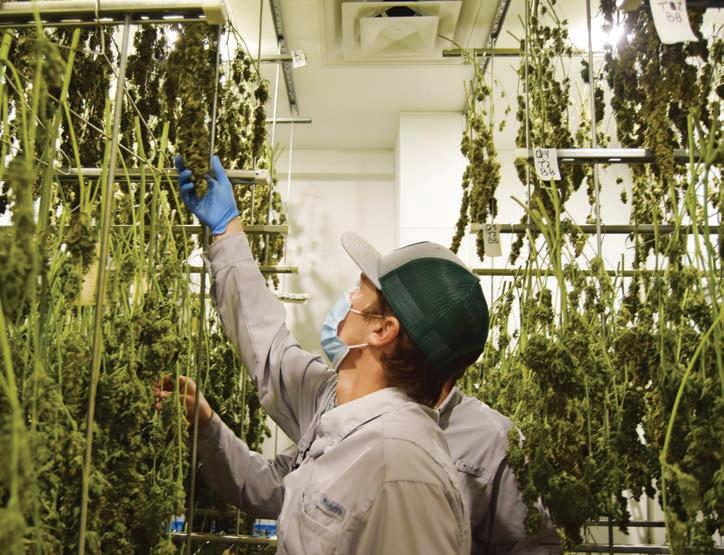
11 minute read
Feature
Medical Green Light
Potential patients can follow this fi ve-step process to obtain medical cannabis in Texas
Advertisement
BY TRAVIS E. POLING
There’s a good chance a li le bit of cannabis daily can ease many common ailments from epilepsy and muscle spasms to PTSD and the side eff ects of cancer. Low doses of medical cannabis are legally approved in Texas, but don’t expect to swing by your neighborhood pharmacy to fi ll the prescription along with a vial of insulin and blood pressure pills.
The state’s Compassionate Use Program for medical marijuana, put in place by the Texas Legislature in 2015 and expanded in 2019 and 2021, is among the most restrictive in the nation. There are a lot of caveats, and it’s overseen by the state agency best known for issuing driver’s licenses and speeding tickets.
According to the Regulatory Services Division of the Texas Department of Public Safety, which oversees medical cannabis for the state, there were 22,221 patients registered for the program in March, up from fewer than 5,000 a year prior. Those numbers are expected to grow, but without a retail-like dispensary system found in other states, it takes some work to go from diagnosis to receiving the medication.
Here’s a fi ve-step guide to navigating the Texas system.
1. Diagnosis
A physician can recommend cannabis to treat a patient’s symptoms, but it takes a doctor approved by and registered with DPS to prescribe tinctures, gummies and lozenges containing state-approved amounts of THC, the psychoactive compound in cannabis.
Potential patients can check the DPS Compassionate Use Program website at dps.texas.gov/section/compassionate-use-program for a list of qualifying conditions, contact a licensed cannabis clinic directly or start the process through one of the state’s few producers.
Texas Original Compassionate Cultivation, based in Manchaca on the outskirts of Austin, also has a list of approved uses on its website and an online form people can use to obtain an appointment with a clinic.
Staff at a partner clinic will review the patient’s medical records and see if there’s anything that would qualify them for a prescription. For example, a person with diabetes might be eligible because of foot pain from neuropathy or qualify for treatment of spasticity because of a previous prescription for muscle relaxants.
“You don’t have to be eligible right off the bat,” said Rodrigo Cravey, head of patient experience at Texas Original.
By the time the updated Compassionate Use Program expanded last fall to include PTSD, or post-traumatic stress disorder, many Texas veterans had already been diagnosed, and Cravey said there was a fi gurative “line at the gates.” That addition to the law has been a primary cause of the spike in medical cannabis demand over recent months, he said.
People with schizophrenia, which could worsen with cannabis, aren’t eligible. Also, women who are pregnant or breastfeeding babies can’t get a prescription because it’s unknown what eff ect the cannabis could have on the unborn, and THC concentrates by about 40 times in breast milk.
2. Registration
A physician with a specialty in cannabis sees the patient to fi gure out the best route to take for their ailment, then enters the patient’s name with a state registry. While the state collects the data, it’s still covered by federal privacy laws and only authorized physicians and registered dispensary staff can access those details on their patients and clients. Both staff and physicians have gone through DPS background checks.
3. Prescription
Dr. Ma hew Brimberry, who opened Texas Cannabis Clinic in 2019 and now has more than 2,000 patients, said it’s important to have a relationship with a physician with abundant experience with the uses of medical cannabis. Ensuring the right form and dosage of the medicine isn’t a one-size-fi ts-all endeavor.
For example, a child with epilepsy or a geriatric patient with anxiety from dementia might have vastly diff erent needs than a young military veteran with PTSD who already has experience using cannabis.
Experienced physicians should take those factors into account, so a patient gets the maximum medical benefi t from ingesting the THC without reaching the level of inebriation, or high, sought by recreational users. Recreational cannabis found in states where it’s legal has much higher THC levels by volume than the Texas’ medical formulation, which is capped at 1%.
Medical doses can range from 1.25 milligrams to 5 milligrams taken orally once or twice a day, Brimberry said. For most people, inebriation from THC starts at about 7 milligrams, but the compound connects to everyone’s receptors diff erently.
Courtesy Photo / Texas Original Compassionate Cultivation
4. Pickup
Once the patient is registered, seen by the doctor and the prescription sent to a registered dispensary, coordinators for the dispensary work with the patient on what form the THC will come in, such as a chewable gummy or a drinkable tincture. The dispensary will take payment in what equates to cash, such as a check, money order, direct withdrawal from a bank account or a bank debit card, Cravey noted. Because cannabis is still illegal at the federal level, regulations prevent the use of credit cards.
Federal prohibition also prevents delivery by mail, and Texas law requires dispensaries to be vertically integrated. That means the same facility grows the marijuana plants, harvests the fl ower buds, processes them, manufactures the delivery forms and stores them. To make products available to consumers, growers deliver to cities throughout the state at fi xed drop-off points. Texas Original, for example, makes deliveries to a San Antonio pickup spot near the South Texas Medical Center every Tuesday from 11 a.m. to 2 p.m. As demand picks up across the state, the company is adding routes, and a new facility is in the works in Bastrop.
5. Follow-up
While the state doesn’t require a specifi c follow-up period for a patient to see the doctor, clinics schedule appointments to check how the treatment is working. Brimberry said his clinic typically schedules a follow-up and subsequent appointments every six months. The doctor must renew the patient’s spot on the state registry every year for prescriptions to continue.
For children, the elderly and fi rst timers, also known as the “cannabis naïve,” the fi rst follow-up is usually just two to three weeks after the substance is prescribed, Brimberry said.
GLITTER POLITICAL
The personal and political evolution of state Rep. Ina Minjarez, candidate for Bexar County judge
BY JADE ESTEBAN ESTRADA
It’s a windy Tuesday afternoon as I sit across from Texas Rep. Ina Minjarez at Viola’s Ventanas in Northwest San Antonio. Though not readily apparent to onlookers from her calm composure, the El Paso native is locked in a May 24 runoff with former district court Judge Peter Sakai to represent the Democratic Party in the highstakes race for Bexar County judge.
A silver bracelet with beads dangles from Minjarez’s right wrist. She explains that it’s a gift from Texas Rep. Jessica González, something the North Texas Democrat picked up on a trip to Europe.
I ask about one of the images on the beads.
“It’s a cross with a fl ower,” replies Minjarez, 46, examining it anew. “I think you can do the rosary on it.”
During her seven years as a legislator under the Pink Dome, I have twice interviewed Minjarez for this column. The fi rst was in 2018, the second in late 2020.
Much has transpired since then. For one, she survived the political backlash from being one of the 50 House Democrats who fl ed to Washington, D.C. in a bid to block a raft of Republican-led voting restrictions. That high-profi le departure happened shortly after the unexpected passing of her beloved mother-in-law.
Minjarez said that death made her reexamine the balance between family life and passion for public service. I ask her how the Ina si ing before me is different from the one I fi rst met in 2018.
“I think Ina’s grown,” she says, playing along with the third-person perspective. “Ina’s evolved. A lot has happened since we last visited.”
Minjarez’s decision to run for Bexar County judge came as a surprise to political observers, who projected a longer tenure for her in the GOP-controlled Texas House. To run for the center seat on Commissioners Court, Minjarez wasn’t required to resign as representative, but her name couldn’t be on the ballot for re-election.
But it’s not as if she hasn’t calculated the risks. Bexar County Judge Nelson Wolff , who assumed offi ce in 2001, is a Democrat, and according to pollsters hired by Minjarez’s campaign, there’s a strong chance the seat will remain blue.
“It will be very diffi cult for a Republican to fi nd a path, just because the dynamics of the population of Bexar County have changed so much over the years,” Minjarez says. “We are an urban core that’s predominantly Democrat.”
Though it’s a midterm election, which tends to a ract fewer voters than a presidential election year, Minjarez is counting on Beto O’Rourke’s gubernatorial run to galvanize the county’s Democratic base. That would boost her campaign if she wins her party’s nomination next month.
“He’s a dynamic politician,” she says of the El Paso progressive, who lost his 2018 senatorial bid by a three-point margin. “He’s going to bring out the Democrats.”
In the eyes of some local party insiders, Minjarez’s candidacy was an unexpected disruption to the status quo.
“The old guard of the party were upset with me for running,” she says. “They felt, ‘You needed to have asked us for permission. You should allow Judge Sakai to run because he’s been around longer. You should wait your turn.’”
No stranger to opposition, Minjarez says the local party brass isn’t necessarily refl ective of the county’s “general” Democratic voters.
“I dealt with the same challenges when I ran for [House District] 124, so although I respect the party and, of course, the people in it, I know that how I win is by talking to and aggressively meeting the Democratic voters that are on the outside of the bubble.”
Minjarez notes that the relationships she built while serving in the House would help her as a county judge.
“This position ... it’s not one that comes all the time,” she says. “I decided I can come home and work on the same policies I did up there and actually get things done on the local level.”
I ask what other ways she feels like she’s changed.
“I think I’m more assertive at times,” she replies. “Now, I’m just very direct. Just tell me what you want. If we can’t get there, then I’m gonna fi nd another way to get it done.”
One of Minjarez’s top priorities is property tax relief, which she says hasn’t been meaningfully addressed at the legislature. She’s also focused on infrastructure, planning responsible growth and quality-of-life issues such as housing, healthcare, mental health issues and generational poverty.
She says businesses should play a part in some of those initiatives and bring their perspectives to the table.
“If your workers are well and your people are well, we thrive economically,” Minjarez explains. “If you’re not addressing mental health, proper healthcare, food deserts [or] housing, how do you expect people to thrive and contribute to your business?”
If I were to ask you for the best advice you’ve ever received, what comes to mind, right here, right now? I ask.
“My husband gave me some great advice that’s always stuck with me: ‘What you allow, you promote,’” she says. “There’s a way to address something that bothers you in a way that you let it be known that you don’t like something. If you don’t address it, it continues to grow. They think by your silence, you were OK with it.”
Though Minjarez is disappointed by the current leadership in the Texas House, she’s nonetheless heartened to see more women entering public offi ce.
“Women bring a diff erent dynamic and perspective,” she says. “For me, the more women the be er. I look forward to the day when we see another female governor, but I’d like to see a female speaker or a female lieutenant governor.”
She nods.
“That’s going to be cool. I hope I’m still around for that.”

Jade Esteban Estrada


beauty



Follow the smokestacks to seasonal favorites, free f lowers and Mother’s Day photo !
Get a free mini bouquet and digital photo with your same-day purchases totaling $75 or more from at least two Alamo Quarry Market stores or restaurants. To collect your fresh Spring flowers, bring current day’s receipts to the pop-up at these locations. Plus, enter for a chance to win $100 in prizes.
MONDAY MAY 2 | 1 - 3pm


Bath & Body Works
TUESDAY MAY 3 | 1 - 3pm
Kay Jewelers
One per customer. While supplies last. Employees and their families of Alamo Quarry Market and all of its tenants are not eligible.
Follow the smokestacks to San Antonio’s premier lifestyle shopping center featuring over 75 uniques shops and fabulous choices for fine and casual dining. Highway 281 at 255 East Basse Road | (210) 824-8885 | QuarryMarket.com | Follow us




